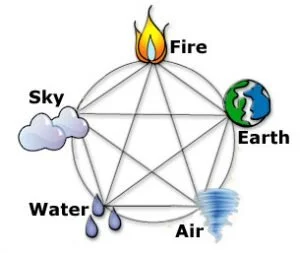Shiva 5-Ohm
Shiva is personified as 5 Elements of Air, Water, Fire, Earth & Space
Wondering and wandering
I have always been fascinated by different cultures and how they intermingle. As a multi culti masala mix myself, Ive been interested in how people from different parts of the world see things, and how that is similar or dissimilar to the way I was brought to see things. And in travelling around the world for most of my life, Ive found there are more similarities that there are differences. Perhaps this is why I always believe we have a chance to promote peace on this planet by learning about our neighbours in other cultures.
Nature and Ishwara
The beliefs of the subcontinent of India share a similar single Reality, and revere the manifestations of Ultimate Reality in the form of Gods. Every form of creation is regarded as a manifestation of the supreme reality Ishwara, and manifested as a combination of one or more of the five basic elements.
5 Elements
Air - Vayu
Water - Jalam
Fire - Agni
Earth - Prithvi
Space - Akasha
The Five Elements
Prithvi - Earth is the lowest element. Shape is square, color yellow, sense is smell, function is elimination(anus), deity is Ganesha, chakra is muladhara, bija is "Lam."
Jalam - Water is the second element. Shape is crescent, color silver, sense is taste, function is reproduction (sex organ), deity is Vishnu, chakra is svadishtana, bija is "Vam."
Agni - Fire is the third element. Shape is triangle, color red, sense is vision, function is transportation (feet), deity is Surya, chakra is manipura, bija is "Ram."
Vayu - Air is the fourth element. Shape is round, color blue or black, sense is touch, function is manipulation (hands), deity is Shiva, chakra is anahita, bija is "Yam."
Akasha - Space is the highest element. Shape is like a flame, color purple, sense is hearing, function is communication (throat), deity is Devi, chakra is vishuddha, bija is "Ham."
Shiva and 5 Elements
Five temples in South India worship Shiva personified as these elements Air, Water, Fire, Earth and Space.
These temples are the Shivastalams at Sri Kalahasti in Andhra Pradesh, Tiruvanaikkaval near Tiruchirappalli in Tamilnadu, Tiruvannamalai in Tamilnadu, Kanchipuram in Tamilnadu and Chidambaram in Tamilnadu.The five mantras that constitute Shiva's body are Sadyojaata, Vaamadeva, Aghora, Tatpurusha and Ishana.
Panchamukha lingams have been found from the 2nd century, and the Trimurthi Sadasiva image of Shiva in the Elephant's Caves near Mumbai is a beautiful stone portrayal of the five faces of Shiva.
Ishana is Shiva not visible to the human eye
Sadyojaata is Shiva realised in basic reality (in elements of earth, sense of smell, power of procreation and the mind).
Vishnudharmottara Purana, 6th century CE assigns a face and element to each mantra:
Sadyojaata - Earth
Vaamadeva - Water
Aghora - Fire
Tatpurusha - Air
Ishana - Space
The names of faces with their elements:
Mahadeva - Earth Bhairava - Fire Nandi - Air Uma - Water Sadasiva - Space
Lord Shiva is typically depicted with a white body, signifying purity and his linkage to snowy mountains.
Shiva's five faces, represent five cosmic tasks of creation, establishment, destruction, oblivion, and grace.
Shiva's Faces
The five faces are linked to the primeval symbol of Ohm
Four of the five faces look in the four directions while the fifth looks upward
The white face looking north is Sadyojat (or instantly born)
The red face looking west is Vamadeva (Vama is left and Deva is god) and symbolises ego
The blue or blue-black south face is Aghora (that which is void of darkness), and symbolises intellect.
Tatpurusha (supreme being) is yellow face looking east, representing the form of nature manifested on earth.
The copper face looking upward is Ishana (or supreme ruler), symbolising knowledge in its entirety.
The crescent of the fifth day moon near his head symbolises being one with Time, and his cosmic proportions. It underlines the fact that he controls the mind completely. The crescent moon represents birth and growth, and places the power of procreation along with destruction in the same deity.



